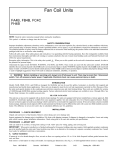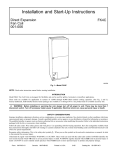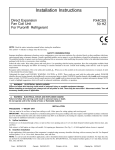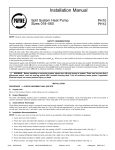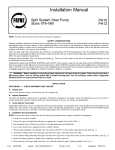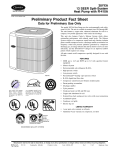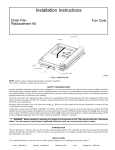Download BDP FC4B Instruction manual
Transcript
Installation Instructions Direct Expansion Fan Coil Units Fan Unit FA4A, FB4A, FC4B FH4A NOTE: Read the entire instruction manual before starting the installation. SAFETY CONSIDERATIONS Improper installation, adjustment, alteration, service, maintenance, or use can cause explosion, fire, electrical shock, or other conditions which may cause personal injury or property damage. Consult a qualified installer, service agency, or your distributor or branch for information or assistance. The qualified installer or agency must use factory-authorized kits or accessories when modifying this product. Refer to the individual instructions packaged with the kits or accessories when installing. Follow all safety codes. Wear safety glasses and work gloves. Use quenching cloth for brazing operations. Have fire extinguisher available. Read these instructions thoroughly and follow all warnings or cautions attached to the unit. Consult local building codes and National Electrical Code (NEC) for special requirements. . When you see this symbol on the unit and in instructions or manuals, be alert Recognize safety information. This is the safety-alert symbol to the potential for personal injury. Understand the signal word DANGER, WARNING, or CAUTION. These words are used with the safety-alert symbol. DANGER identifies the most serious hazards which will result in severe personal injury or death. WARNING signifies hazards which could result in personal injury or death. CAUTION is used to identify unsafe practices which would result in minor personal injury or product and property damage. WARNING: Before installing or servicing unit, always turn off all power to unit. There may be more than 1 disconnect switch. Turn off accessory heater power if applicable. Electrical shock can cause personal injury or death. Table 1—Accessories ACCESSORY Power Plug Kit (25 pack) PART NO. KFAPP0125PLG KFADC0201SLP Downflow Coil Conversion Kit* KFADC0301ACL KFACB0101CFB KFACB0201CFB Downflow Base Kit† KFACB0301CFB KFACB0401CFB KFAFKO112SML KFAFK0212MED Filter Kits (12 packs) KFAFK0312LRG KFAFK0412XXL MODEL APPLICATION All Models FA4A, FB4A 018-042, FC4B 024-036, 042 FH4A 001, 002 FA4A, FB4A 048-070, FC4B 038, 048-070 FH4A 003, 004 FA4A, FB4A 018, 024, FC4B 024 FH4A 001 FA4A, FB4A, FC4B 030, 036 FH4A 002 FA4A, FB4A 042-060, FC4B 033-048, 060 FH4A 003, 004 FB4A 070, FC4B 054, 070 FA4A 018, 024, FB4A 018, 024, FC4B 024, FH4A001 FA4A 030, 036, FB4A 030, 036, FC4B 030, 036, FH4A002 FA4A 042-060, FB4A 042-060, FC4B 033, 038, 042-060 FH4A 003, 004 FB4A 070, FC4B 054, 070 * Required to mount coil in unit, including condensate control parts. † Eliminates open passage through building floor per UL and NFPA90B. INSTALLATION PROCEDURE 1—MOUNT UNIT Unit can stand or lie on floor, or hang from ceiling or wall. Allow space for wiring, piping, and servicing unit. IMPORTANT: When unit is installed over a finished ceiling and/or living area, building codes CABO M-1701.2, UMC 1205, or SBCCI 603.4 may require a field-supplied secondary condensate pan to be installed under the entire unit or unit to have a secondary condensate line. Form: IM-FA4A-03 Cancels: IM-FA4A-02 Printed in U.S.A. 1-95 Catalog No. 92-33FA-4A18 A. Upflow Installation If return air is to be ducted through a floor, set unit on floor over opening and use 1/8- to 1/4-in. thick fireproof resilient gasket between duct, unit, and floor. Side return is a field option on slope coil models. Cut opening per dimensions. (See Fig. 1.) A field-supplied bottom closure is required. POWER ENTRY OPTIONS FIELD SUPPLIED SUPPLY DUCT LOW VOLT ENTRY OPTIONS 24-IN. FRONT SERVICE CLEARANCE UNIT 018/024 030/036 042 A-COIL UNITS UPFLOW/DOWNFLOW SECONDARY DRAIN A 12 In. 17 In. 19 In. 1 1⁄2″ UPFLOW/DOWNFLOW PRIMARY DRAIN 19″ A 2 1⁄2″ FIELD-MODIFIED SIDE RETURN LOCATION FOR SLOPE COIL UNITS ONLY UPFLOW/DOWNFLOW SECONDARY DRAIN UPFLOW/DOWNFLOW PRIMARY DRAIN FIELD-SUPPLIED RETURN PLENUM A91424 Fig. 1—Slope Coil Unit in Upflow Application B. Downflow Installation In this application, field conversion of the evaporator coil is required along with an accessory base kit. Refer to Table 1 for kit part numbers. C. Horizontal Installation Units must not be installed with access panels facing up or down. The FH4A003 and 004 size units equipped with accessory cooling coils are not approved for horizontal applications. All other units are factory built for horizontal left installation. When suspending unit from ceiling, dimples in casing indicate suitable location of screws for mounting metal support straps. (See Fig. 2.) NOTE: To ensure proper drainage for horizontal installations, unit must be installed level with its long direction and pitched slightly toward the unit front (1/16- to 1/4-in.); for upflow or downflow applications, unit should be level or pitched slightly toward unit front (1/16- to 1/4-in.). NOTE: Modular units can be disassembled and components moved separately to installation area for reassembly. This process accommodates small scuttle holes and limiting entrances to installation sites. (See Fig. 3.) HORIZONTAL RIGHT CONVERSION OF UNITS WITH SLOPE COILS 1. Remove blower and coil access panels and fitting panel. (See Fig. 4.) 2. Remove coil mounting screw securing coil assembly to right-side casing flange. 3. Remove coil assembly. 4. Lay fan coil unit on its right side and reinstall coil assembly with condensate pan down. (See Fig. 4.) 5. Attach coil to casing flange using coil mounting screw previously removed. 6. Align holes with tubing connections and condensate pan connections, and reinstall access panels and fitting panel. Make sure liquid and suction tube grommets are in place to prevent air leaks and cabinet sweating. Install after brazing. HORIZONTAL RIGHT CONVERSION OF UNITS WITH A-COIL 1. Remove blower and coil access panels. (See Fig. 5.) 2. Remove clip securing fitting panel to condensate pan. Remove fitting panel. 3. Remove 2 snap-in shipping clips securing A-coil in unit. —2— A-COIL IN HORIZONTAL LEFT SECONDARY PRIMARY FIELD SUPPLIED HANGING STRAPS 24-IN. FRONT SERVICE CLEARANCE (FULL FACE OF UNIT) UNIT LOW VOLT ENTRY OPTIONS OPTIONAL RETURN AIR FLANGE KIT PRIMARY CONDENSATE DRAIN POWER ENTRY OPTIONS SECONDARY CONDENSATE DRAIN 1 3/4 IN. FILTER ACCESS CLEARANCE A90167 Fig. 2—Slope Coil Unit in Horizontal Left Application BLOWER BOX 2 SCREWS 2 SCREWS REAR CORNER BRACKET 2 SCREWS COIL BOX A90168 Fig. 3—Removal of Brackets on Modular Unit —3— COIL MOUNTING SCREW BLOWER ASSEMBLY COIL SUPPORT RAIL COIL SUPPORT RAIL SECONDARY CONDENSATE DRAIN REFRIGERANT CONNECTIONS PRIMARY CONDENSATE DRAIN A90174 Fig. 4—Conversion for Horizontal Right Applications Using a Slope Coil A REFRIGERANT CONNECTIONS AIR SEAL ASSEMBLY HORIZONTAL RIGHT APPLICATION COIL SUPPORT RAIL B C COIL BRACKET DRAIN PAN SUPPORT BRACKET COIL SUPPORT RAIL C B FACTORY SHIPPED COIL BRACKET METAL HORIZONTAL DRAIN PAN SECONDARY CONDENSATE DRAIN PRIMARY CONDENSATE DRAIN A A91119 Fig. 5—Conversion for Horizontal Right Applications Using A-Coil 4. Remove coil assembly. 5. Remove metal horizontal drain pan from coil assembly. 6. Remove horizontal drain pan support bracket from coil support rail and reinstall to the opposite side of the coil support rail. 7. Remove condensate drain plugs from 1 side of horizontal drain pan and install in drain connection openings on opposite side. 8. Convert air-seal assembly for horizontal right. a. Remove air-seal assembly from coil by removing 4 screws. b. Remove air splitter (B) from coil seal assembly by removing 3 screws. (See Fig. 5—factory-shipped inset.) —4— c. Remove filler plate (A) and install air splitter (B) in place of filler plate. d. Install filler plate (A) as shown in horizontal right application. e. Remove condensate troughs (C) and install on opposite tube sheets. f. Install hose onto plastic spout. 9. Install horizontal pan on right side of coil assembly with plugged condensate openings to rear of assembly. 10. Slide coil assembly into casing. Be sure coil bracket on each corner engages coil support rails. 11. Remove condensate drain knockouts from right side of coil access panel. 12. Reinstall access and fitting panels, aligning holes with tubing connections and condensate pan connections. Make sure liquid and suction tube grommets are in place to prevent air leaks and cabinet sweating. PROCEDURE 2—AIR DUCTS Connect the supply-air duct over the outside of the 3/4-in. flanges provided on the supply-air opening. Secure the duct to the flange, using proper fasteners for the type of duct used, and seal the duct-to-unit joint. If return-air flanges are required, install factory-authorized accessory kit. Use flexible connectors between ductwork and unit to prevent transmission of vibration. When electric heater is installed, use heat-resistant material for flexible connector between ductwork and unit at discharge connection. Ductwork passing through unconditioned space must be insulated and covered with vapor barrier. A. Ductwork Acoustical Treatment Metal duct systems that do not have a 90° elbow and 10 ft of main duct to first branch takeoff may require internal acoustical insulation lining. As an alternative, fibrous ductwork may be used if constructed and installed in accordance with the latest edition of SMACNA construction standard on fibrous glass ducts. Both acoustical lining and fibrous ductwork shall comply with National Fire Protection Association as tested by UL Standard 181 for Class 1 air ducts. JW1 C T G C5 R HSCI ® V1 R C6 Z1 F1 NC R3 Q1 R1 C1 NO SPT K1 C2 LOW VOLTAGE FUSE T 5 AMP R7 D2 FAN RELAY C7 C G C4 CESO130003- R5 LR40061 R9 R2 R3 C3 R6 1005-83-160A R4 1 1005-160 ® PROCEDURE 3—ELECTRICAL CONNECTIONS All products from the factory utilize a new printed-circuit board (PCB) which has the low voltage circuit protective fuse (5 amp) and fan motor speed tap selection terminal (SPT). (See Fig. 6.) D1 FAN RELAY A94057 Fig. 6—Fan Coil Printed-Circuit Board When a factory-approved accessory control package has been installed, check all factory wiring per unit wiring diagram and inspect factory wiring connections to be sure none were loosened in transit or installation. If a different control package is required, see unit rating plate. CAUTION: If a disconnect switch is to be mounted on the unit, select a location where drill or fastener will not contact electrical or refrigerant components. Before proceeding with electrical connections, make certain that supply voltage, frequency, phase, and ampacity are as specified on the unit rating plate. See unit wiring label for proper field high- and low-voltage wiring. Make all electrical connections in accordance with the NEC and any local codes or ordinances that may apply. Use copper wire only. The unit must have a separate branch electric circuit with a field-supplied disconnect switch located within sight from and readily accessible from the unit. —5— A. Line Voltage Connections Units installed without electric heat require the use of a factory-authorized Power Plug Kit (KFAPP0125PLG). This kit provides the electrical connections necessary to supply the unit with 230-v power when electric heat is not present. This kit is required only on those applications which do not use electric heat. NOTE: It is not necessary to cover the opening for accessory heaters. The unit will perform properly with opening uncovered. B. 24-v Control System CONNECTION TO UNIT Wire low voltage in accordance with the wiring label on the blower. (See Fig. 7, 8, 9, 10, and 11.) Use No. 18 AWG color-coded, insulated (35°C minimum) wire to make the low-voltage connections between the thermostat, the unit, and the outdoor equipment. If the thermostat is located more than 100 ft from the unit (as measured along the low-voltage wire), use No. 16 AWG color-coded, insulated (35°C minimum) wire. All wiring must be NEC Class 1 and must be separated from incoming power leads. Refer to outdoor unit wiring instructions for any additional wiring procedure recommendations. THERMOSTAT FAN COIL (CONTROL) THERMOSTAT FAN COIL (CONTROL) R R R R G G G G W W2 W W2 W3 W3 E E AIR COND. C AIR COND. C C C Y Y Y Y A94058 A94059 Fig. 7—Wiring Layout Air Conditioning Unit (Cooling Only) THERMOSTAT FAN COIL (CONTROL) R R G G C C W2 W2 W3 E Fig. 8—Wiring Layout Air Conditioning Unit (Cooling and 1-Stage Heat) HEAT PUMP (CONTROL) THERMOSTAT R C FAN COIL (CONTROL) R R G G C C W2 W2 E E E W3 HEAT PUMP (CONTROL) R C W2 ODTS L W2 L O O O O Y Y Y Y A94060 A94061 Fig. 10—Wiring Layout Heat Pump Unit (Cooling and 2-Stage Heat with 1 Outdoor Thermostat) Fig. 9—Wiring Layout Heat Pump Unit (Cooling and 2-Stage Heat with No Outdoor Thermostat) —6— FAN COIL (CONTROL) THERMOSTAT R R G G C C W2 W2 L W3 E E HEAT PUMP (CONTROL) R C W2 ODTS1 ODTS2 O O Y Y C 1 4 7 C 9 6 3 EMERGENCY HEAT RELAY A94062 Fig. 11—Wiring Layout Heat Pump Unit (Cooling and 2-Stage Heat with 2 Outdoor Thermostats) TRANSFORMER INFORMATION Transformer is factory wired for 230-v operation. For 208-v applications, disconnect the black wire from the 230-v terminal on the transformer and connect it to the 208-v terminal. (See Fig. 12.) SECONDARY YEL BLK 230 208 C BRN RED PRIMARY A94067 Fig. 12—Transformer Connections HEATER STAGING CAUTION: If W2, W3, and E on any 3 sequence heater (18, 24, or 30kw), are individually connected as with outdoor thermostats or any other situation, emergency heat relay must be used. This relay is in kit KHAOT0201SEC and is normally used with kit KHAOT0301FST for 2 outdoor thermostat system. The controls are factory-circuited for single-stage operation. For 2-stage operation, use outdoor thermostat kit KHAOT0301FST, and for 3-stage use both kits KHAOT0201SEC and KHAOT0301FST. When 2 stages are desired, cut W3 at the W2 wire nut, strip and reconnect per the thermostat kit instruction. (See Fig. 10.) When 3 stages are desired, cut the W2 wire nut off and discard. Strip W2, W3, and E and reconnect per thermostat kit instructions. (See Fig. 11.) NOTE: When 3 stages are used or anytime the E terminal is not tied to W2, the emergency heat relay, part of outdoor thermostat kit KHAOT0201SEC must be used. —7— C. Ground Connections WARNING: According to NEC, ANSI/NFPA 70, and local codes, the cabinet must have an uninterrupted or unbroken ground to minimize personal injury if an electrical fault should occur. The ground may consist of electrical wire or metal conduit when installed in accordance with existing electrical codes. Failure to follow this warning could result in electric shock, fire, or death. Use UL-listed conduit and conduit connector for connecting supply wire(s) to unit to obtain proper grounding. Grounding may also be accomplished by using grounding lugs provided in control box. D. Minimum CFM and Motor Speed Selection Units with or without electric heaters require a minimum CFM. Refer to the unit wiring label to ensure that the fan speed selected is not lower than the minimum fan speed indicated. Fan speed selection is done at the fan relay on the printed-circuit board. To change motor speeds, disconnect the fan lead used on the relay terminal (SPT) and replace with the motor speed tap desired. (See Fig. 13.) Save the insulating cap and place on the motor lead removed from the relay. NOTE: In low static applications, lower motor speed tap should be used to reduce possibility of water being blown off coil. PCB FAN RELAY SINGLE SPADE INSULATING CAP (2) MOTOR SPEED TAP LEADS 2 OR 3 SPEED TAP TERMINAL WRAPPER COMMON YELLOW FAN DECK A94068 Fig. 13—Fan Coil Fan Relay and Speed Tap Terminal All units have 3 motor speed taps, except the FA4A 018 through 036. Low speed (red) is designed for mismatch outdoor unit applications. Medium speed (blue) is designed for straight matched operations. High speed (black) is used with high external static duct systems of straight matched systems. PROCEDURE 4—REFRIGERANT TUBING Use accessory tubing package or field-supplied tubing of refrigerant grade. Suction tube must be insulated. Do not use damaged, dirty, or contaminated tubing because it may plug refrigerant flow-control device. ALWAYS evacuate the coil and field-supplied tubing before opening outdoor unit service valves. CAUTION: Solder with low temperature 430°F silver alloy solder and wrap a wet cloth around rear of fitting to prevent damage to factory-made joints. —8— PROCEDURE 5—REFRIGERANT FLOW-CONTROL DEVICE CAUTION: If using a TXV (FC4B factory installed) in conjunction with a reciprocating compressor, a compressor start capacitor and relay are required. Consult outdoor unit pre-sale literature for start assist kit part no. Replace piston if required. Check piston size shown on indoor unit rating plate to see if it matches required piston shown on outdoor unit rating plate. If it does not match, replace indoor piston with piston shipped with outdoor unit. The piston shipped with outdoor unit is correct for any approved indoor coil combination. (See Fig. 14.) BRASS HEX NUT TEFLON SEAL PISTON PISTON RETAINER DISTRIBUTOR BRASS HEX BODY STRAINER A94415 Fig. 14—Refrigerant Flow-Control Device (FC4B Has TXV and Strainer) PROCEDURE 6—CONDENSATE DRAIN Units are equipped with primary and secondary 3/4-in. FPT drain connections. Use a 3/4-in. glue joint with fittings provided for units with A-coils in horizontal applications. CAUTION: For horizontal installations of units with A-coils, use plastic fittings provided. (See Fig. 15.) Use pipe dope. Do not over-torque. Hand-tighten plus 1-1/2 turns. NOTE: When connecting condensate drain, avoid blocking filter access panel, thus preventing removal of filter. NOTE: It is recommended that PVC fittings be used at the plastic condensate pan. Do not over-tighten. Finger-tighten plus 1-1/2 turns. If the coil is located in or above living space where damage may result from condensate overflow, a separate 3/4-in. drain must be installed and run to a place where it is noticeable when used. If a pan is installed underneath entire unit, as advised, run unit secondary line (with trap) into pan, and run condensate line from pan to noticeable place. Prime secondary trap with antifreeze to prevent condensation inside unit. Install a trap in condensate line(s) as close to coil as possible. (See Fig. 16.) Make sure that top of trap is below connection to coil to prevent condensate from overflowing drain pan. Prime primary trap with water, test for leaks, and insulate trap(s) if located above a living area. The drain should be pitched downward at a minimum slope of 1 in. for every 10 ft. Consult local codes for additional restrictions or precautions. START-UP Refer to outdoor unit Installation Instructions for system start-up instructions and refrigerant charging method details. CAUTION: Never operate unit without a filter. Damage to blower motor or coil may result. Units are not shipped with filters. Factory authorized filter kits must be used when locating the filter inside the unit. (See Table 1.) For those applications where access to an internal filter is impractical, a field-supplied filter must be installed in the return duct system. CARE AND MAINTENANCE To continue high performance and minimize possible equipment failure, it is essential that periodic maintenance be performed on this equipment. Consult your local dealer as to the proper frequency of maintenance and the availability of a maintenance contract. The ability to properly perform maintenance on this equipment requires certain mechanical skills and tools. If you do not possess these, contact your dealer for maintenance. The only consumer service recommended or required is filter replacement or cleaning on a monthly basis. —9— SECONDARY (TRAP REQUIRED) S PRIMARY 2 1/4-IN. MIN SECONDARY FITTING WITH BUILT IN DAM PRIMARY FITTING FILTER ACCESS PANEL 2 1/4-IN. MIN A90347 Fig. 15—Primary and Secondary Fittings for A-Coil Horizontal Applications © 1995 CAC / BDP P.O. Box 1667, Indianapolis, IN 46206 imfa4a03 A90173 Fig. 16—Condensate Drain —10— Book/Tab: 1/3d, 4/2e Catalog No. 92-33FA-4A18












